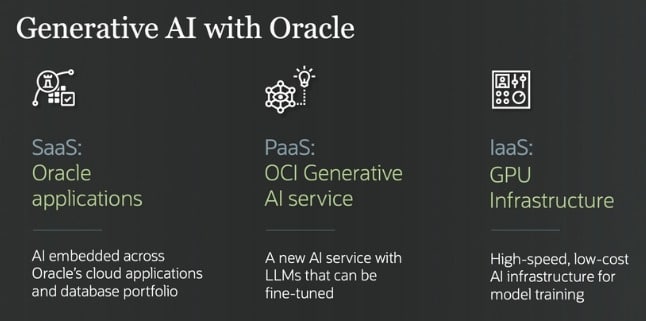
With Generative AI now driving enterprise transformation initiatives, developers are looking into infusing the technology into applications. The result is intelligent applications that deliver numerous business benefits, including better decision-making, reduced human error, and personalized customer service. Developers require a combination of capabilities for use in AI-infused applications. A solid underlying abstracted infrastructure removes the management complexity required for rapid application development. In addition, a collection of developer tools accelerates the application development lifecycle. Obtaining value from Generative AI applications requires a high-performance computing capacity to fine-tune customized large language models (LLMs) to specific business cases. The topics below cover several areas where Oracle announced new features:
Developer Productivity: At the conference, Oracle unveiled new application development capabilities for Oracle Cloud Infrastructure (OCI), targeting cloud-native and Java developers. These enhancements facilitate the building of cloud-native applications while reducing costs. OCI Functions powered by GraalOS address slow cold starts while reducing memory usage and boosting overall performance.
Infrastructure optimization is becoming popular among cloud providers, and Arm-based processors are an ecosystem powering increasing cloud workloads. Oracle’s announcement of Arm support allows cost-effective CPU utilization across various runtimes, including OCI Functions and Oracle Container Engine for Kubernetes (OKE) nodes. The cost and compute efficiency combination helps developers improve end-user application experience and save costs to invest in new initiatives.
AI Strategy: While Generative AI has many benefits, there are concerns about risks associated with intellectual property rights. The complexity of building Gen AI services from an infrastructure and developer tools perspective slows enterprise adoption. Oracle’s AI strategy consists of initiatives that fall into the three cloud computing delivery categories, including Software as a Service (SaaS), Platform as a Service (PaaS), and Infrastructure as a Service (IaaS). See Figure 1 above.
For SaaS, Oracle plans to embed generative models from Cohere across its cloud applications like Oracle Fusion Cloud Applications Suite, Oracle NetSuite, and industry applications like Oracle Cerner. These capabilities will provide SaaS users immediate benefits with Generative AI-augmented productivity and decision-making tools. Customers do not need to worry about intellectual property rights since Oracle does not use customer-owned data to train models for other customers. Oracle intends to use LLMs to generate applications from natural language descriptions in Oracle APEX. This low-no code solution enables non-technical employees to use the Oracle Autonomous Database.
In the PaaS category, OCI developers get access to foundational models with the ability to customize and tune the models in a secure environment for application use. In collaboration with Cohere, OCI Generative AI’s API-enabled service will help developers build generative AI capabilities into custom applications. Powered by OCI AI services, Oracle Analytics Cloud accelerates decision-making by adding features like AI-powered document understanding and contextual insights. Customers using the Oracle developer platform can use AI Vector Search, a component of Oracle Database 23c, to leverage the retrieval augmented generation (RAG) technique that combines LLMs with private data for higher accuracy responses.
For IaaS, Generative AI capabilities announced at the conference included faster computing for AI workloads with a new generation of NVIDIA GPUs, further enhancing OCI Supercluster technology. This will enable customers to reduce the time it takes to train large AI models, such as those that power natural language processing and recommendation systems. Oracle’s RDMA over Converged Ethernet (ROCE) delivers highly efficient networking required by Generative AI workloads in the OCI Supercluster architecture.
Summary:
With the launch of ChatGPT, Generative AI adoption has captured the mindset of the global business community; major cloud providers are quickly launching Generative AI offerings to capture market share. Oracle is no exception. Oracle’s recent announcements enhance OCI application development capabilities to enable faster development. The availability of LLM functionality will provide developers with the ability to embed Generative AI functionality into applications easily. As a full-stack cloud provider, Oracle infuses Gen AI capabilities into its databases, analytics offerings, and SaaS applications. This makes Oracle a key contender for clients’ minds and wallet share.
Ram Viswanathan, Consultant and ex-IBM Fellow, contributed to this blog post.
